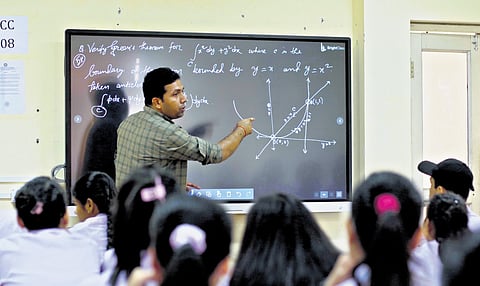

Watching his bespectacled, grey-haired and erudite professor struggle with the challenges of writing on a diminutive smart board in 2009 in a lecture hall at the Indian Institute of Management, Shillong, inspired Nishant Rajawat to create an ‘easy-breezy’ touchscreen smart board. Today, it is being used in 1.5 million schools in India. Rajawat is the founder of Bengaluru-based Cybernytx which is on a mission to transform any flat surface into a touchscreen using their EyeRIS technology, called the ‘ChatGPT of education’.
Currently being used in schools across Hyderabad, Kerala, Tamil Nadu, Uttar Pradesh, Delhi, Gujarat, Maharashtra, Rajasthan, etc, this smart board offers up to 255 simultaneous touch points that convert handwritten words (using a stylus/pen-like gadget) into typed text. It can also pull out the right video or illustration for the students based on their age group, their class/grade, their language proficiency and other factors. The response time is an incredible 8 milliseconds.
Established in 2009 through a research project at the University of Toronto, Cybernetyx created EyeRIS, the first-ever interactive display that works on any flat surface. It can turn surfaces into touchscreens. EyeRIS is gesture-supported so there is zero learning curve for teachers. The user interface of these boards, costing about Rs 25,000, is similar to that of mobile phones.
The teacher doesn’t have to prepare any notes or do the talking. For instance, he will write ‘photosynthesis’ with his finger on the search box, fill in the class, age group, language, etc and the Intellispace software (that powers EyeRIS) processes the facts, figures, definition, explanation, illustration and videos and pops up it onto the board. “AI takes into consideration the group’s overall intellect and picks out a NASA video on photosynthesis and water cycles,” he elaborates. Cybernetyx works with NEC Technologies India Limited and NEC Singapore, as well as collaborations with major educational institutions.
While it seemed like a breeze to convert all smart boards into AI-enabled ones, the team faced a challenge with the fact that most students below Class X don’t have their own mobile phones. They depend on their parents and need to use it when it is at home. “We fixed the gap by doing some innovations such that everything that happened in the classroom was available on the cloud which the student can access on their smart TVs at home. Using the TV remote, they can pick multiple-choice answers or answer a poll. Plus there’s the joy of reading on a big screen. A win-win for the teacher, student and the parent,” he explains.
Rajawat is proud of the fact that he is teaching Gen Z with tools they understand, speaking the language of the digital natives.